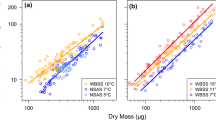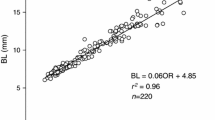Abstract
Growth and developmental rates were determined for copepodids of Calanus finmarchicus (Gunnerus) from experimental seawater mesocosms in a western Norwegian fjord. The instantaneous growth rates (g) from copepodid stage I (CI) to adult ranged from 0.08 to 0.10 d−1. Daily per capita mortality rate of the cohorts was as low as 0.012 d−1 (1.2% d−1). At local increasing temperatures (5.1 to 8.3 °C), development was equiproportional, and the cumulative median development time from egg to CV was approximately 65 d. CV moulted to males and females, and egg production was initiated. Enhancement of food resources by nutrient addition caused a 23.4% increase in growth rates from CI to adult. Additionally, copepodid stages showed a generally larger body size, carbon and nitrogen content and total storage lipid content (wax esters + triacylglycerols) in response to enhanced resources. Our data support an elsewhere proposed exponential-growth hypothesis; growth of the structural compartments and store lipids (mostly wax esters) was exponential during the copepodid stages. However, a sigmoidal pattern of growth best described growth of adult stages if reared at high resources, and depot lipid accumulation in late CVs and adults at high resources. Body nitrogen growth increased exponentially, however, no significant changes in nitrogen specific growth rates were found between individuals from low and high resources. CV and adults seem to have reached near-maximal weights at high resources, whereas structural weight continued to increase at low resources. Despite the differences in structural growth dynamics, cohort development was similar until the end of CV. During the onset of sexual differentiation, the male:female ratio and the adult:CV ratio were highest at high food resources, suggesting that the time used for the final moult depends on the feeding history of the copepods in relation to food quality and quantity. It appears that relatively small changes in food availability strongly influence the biochemical composition of C. finmarchicus copepodids.
Similar content being viewed by others
Author information
Authors and Affiliations
Additional information
Received: 28 May 1999 / Accepted: 10 February 2000
Rights and permissions
About this article
Cite this article
Hygum, B., Rey, C., Hansen, B. et al. Importance of food quantity to structural growth rate and neutral lipid reserves accumulated in Calanus finmarchicus. Marine Biology 136, 1057–1073 (2000). https://doi.org/10.1007/s002270000292
Issue Date:
DOI: https://doi.org/10.1007/s002270000292




